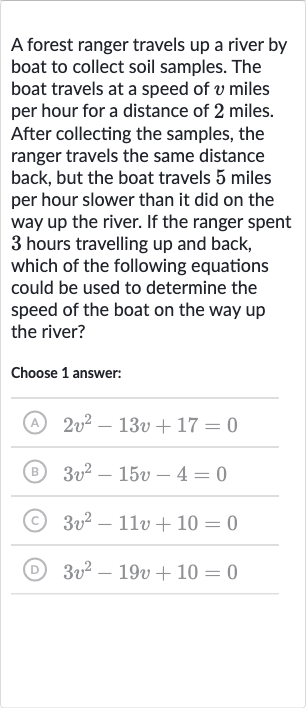AI tutor
Welcome to Bytelearn!
Let’s check out your problem:

A forest ranger travels up a river by boat to collect soil samples. The boat travels at a speed of miles per hour for a distance of miles. After collecting the samples, the ranger travels the same distance back, but the boat travels miles per hour slower than it did on the way up the river. If the ranger spent hours travelling up and back, which of the following equations could be used to determine the speed of the boat on the way up the river?Choose answer:(A) (B) (C) (D)
Full solution
Q. A forest ranger travels up a river by boat to collect soil samples. The boat travels at a speed of miles per hour for a distance of miles. After collecting the samples, the ranger travels the same distance back, but the boat travels miles per hour slower than it did on the way up the river. If the ranger spent hours travelling up and back, which of the following equations could be used to determine the speed of the boat on the way up the river?Choose answer:(A) (B) (C) (D)
- Denote Speed and Distance: Let's denote the speed of the boat on the way up the river as miles per hour. The distance traveled up the river and back is the same, which is miles each way. The time it takes to travel up the river is the distance divided by the speed, which is hours. On the way back, the boat is traveling miles per hour slower, so the speed is miles per hour. The time it takes to travel back is the distance divided by this slower speed, which is hours. The total time spent traveling is the sum of these two times, which is given as hours. Therefore, we can set up the equation:
- Set Up Equation: Now we need to solve this equation for . To do this, we need to find a common denominator for the two fractions on the left side of the equation. The common denominator is . We multiply both sides of the equation by this common denominator to eliminate the fractions:
- Solve for : Simplifying the equation, we get:This simplifies to:
- Common Denominator: Combining like terms on the left side gives us:Now we want to set the equation to zero by moving all terms to one side:
- Simplify Equation: Simplifying the equation further, we combine the terms: This is a quadratic equation in standard form.
- Combine Like Terms: Looking at the answer choices, we see that the equation we derived, , matches choice (D).
More problems from Evaluate two-variable equations: word problems
QuestionGet tutor help
QuestionGet tutor help
QuestionGet tutor help
QuestionGet tutor help
QuestionGet tutor help
QuestionGet tutor help
QuestionGet tutor help
QuestionGet tutor help
QuestionGet tutor help
QuestionGet tutor help
